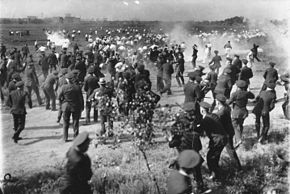
The Little Steel strike was a 1937 labor strike by the Congress of Industrial Organizations (CIO) and its branch the Steel Workers Organizing Committee (SWOC), against a number of smaller steel producing companies, principally Republic Steel, Inland Steel, and Youngstown Sheet and Tube Company. The strike affected a total of thirty different mills belonging to the three companies, which employed 80,000 workers. The strike, which was one of the most violent labor disputes of the 1930s, ended without the strikers achieving their principal goal, recognition by the companies of the union as the bargaining agent for the workers.
On March 13, 1937, the United States Steel Corporation (US Steel) signed a historic collective bargaining agreement with SWOC.[1] The agreement provided for a standard pay scale, an 8-hour work day, and time and a half for overtime. Although US Steel ("Big Steel") signed the deal, there were smaller companies that refused to sign. That is why the strike is known as the "Little Steel" strike: US Steel Corporation was so massive that it gave rise to the moniker "Little Steel" for its four smaller competitors, Republic Steel Corporation, Bethlehem Steel Corporation, Youngstown Sheet & Tube Company, and Inland Steel Company, each ranked among the hundred largest firms in America.[1]
The strike did not start immediately. In fact, there was an expectation that Little Steel would follow Big Steel's lead and sign a deal with SWOC. On March 30, 1937, SWOC proposed an agreement similar to the one with US Steel to Little Steel. The proposal sought an eight-hour work day, a forty-hour work week, overtime pay, a $5-per-day minimum wage, paid vacations, health and safety standards, seniority, and procedures for resolving grievances. Rather than sign, Little Steel representatives met, debated, dragged their feet, sent spies to infiltrate SWOC, and prepared for actual battle. The companies bought poison gas and other weapons, hired private police, donated weapons to official law enforcement, encouraged law enforcement to hire more deputies, stocked their plants with food and bedding, installed search lights and barbed wire, and fired hundreds of union workers.
The Little Steel Strike started on May 26, 1937, when the US economy was just starting to recover from the Great Depression. Steel workers, represented by the CIO affiliated Steel Workers Organizing Committee (SWOC) participated in protests ranging from sit-ins to picket lines. Within days of SWOC's authorization of the strike, 67,000 workers were off the job and the scattered violence that began to erupt was a harbinger of more dire things to come.[1]
The strike is characterized as one of the most violent strikes of the 1930s, with thousands of strikers arrested, three hundred injured and eighteen dead. The Little Steel companies eventually defeated the strike, which lasted just over five months time. However, groundwork for the unionization of the Little Steel industry was set and the goal to unionize Little Steel occurred five years later, in 1942, as World War II began to ramp up.
- ^ a b c White, Ahmed (2016). The Last Great Strike: Little Steel, the CIO, and the Struggle for Labor Rights in New Deal America. University of California Press. pp. 1-3 (description), 14 (co-opting), 15 (anti-labor stances), 20-21 (lockouts), 46 (Open Shop Era), 89-91 (conditions, unionism), 95-96 (campaign), 101-102 (collective bargaining), 119–129 (from stalemate to walkout), 130-146 (Memorial Day), 149-150 (struggle), 240 (failure). ISBN 9780520961012.
© MMXXIII Rich X Search. We shall prevail. All rights reserved. Rich X Search
